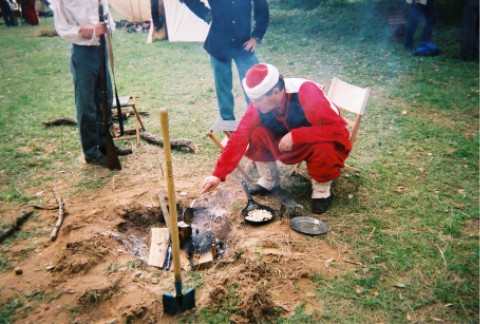See the new wooden oven on the
campfire page.If you want to live like the original Civil War soldiers for a weekend, and appear so to the public, then
w
You should have authentic food in your haversack. (Pop tarts are not a substitute for hard tack!). Even if you intend not to cook, under the principle that troops might be told to "cook three days' rations" before marching, you can display authentic food choices.w
You can cook your own meals. They did. Unlike the 20th-21st century U.S. army, there was no mess section in the table of organization of a unit! Confederate troops usually cooked and lived as a "mess", a voluntary group of about 4-12 men who shared the burdens of carrying utensils and cooking. Federals began the war the same way, but over time and in static situations company mess sections were formed by detail so that late war Federal cooking appears to have been centralized, with some access to a cargo wagon and possibly a mess tent. The U.S. Sanitary Commission even printed brief written guidance for Army cooks!The starving Confederate is probably a wrong impression for most occasions, except mobile campaigns in which the commissary could not keep up (in which case the starving Federal is also appropriate.) The rations indicated below would be ample if issued. For instance, 20 ounces of corn meal is a lot to eat! One post-war memoir refers to a veteran who periodically camped out in the woods and "cooked big messes" such as they used to eat in the army.

Above: The author in zouave impression, cooking breakfast in camp at Liendo 2003 with mucket, skillet, and tin plate. The chair is optional.
Contents of this section:
2. Haversack food - food to bring to a reenactment
6. Camp Fire Recipes